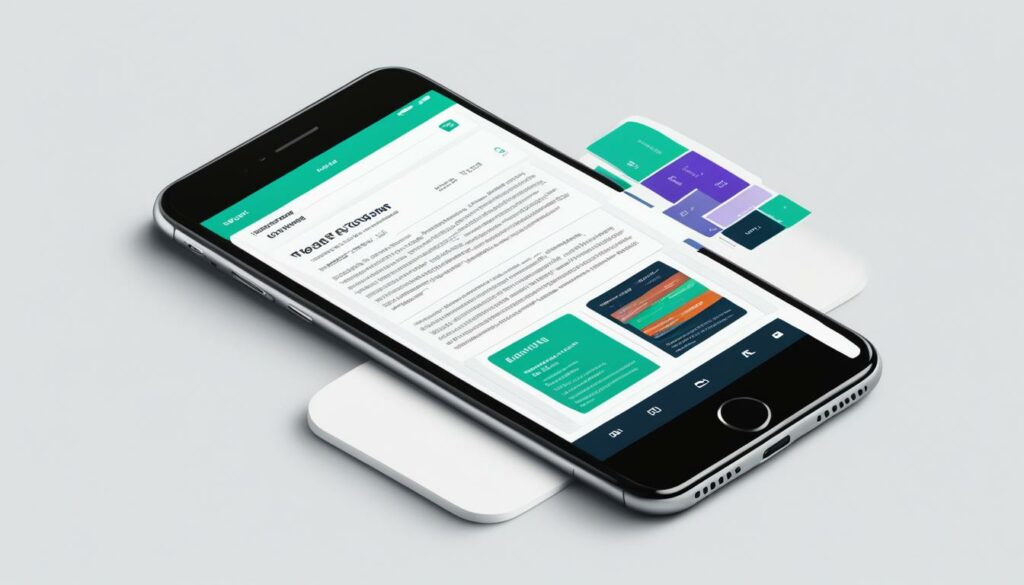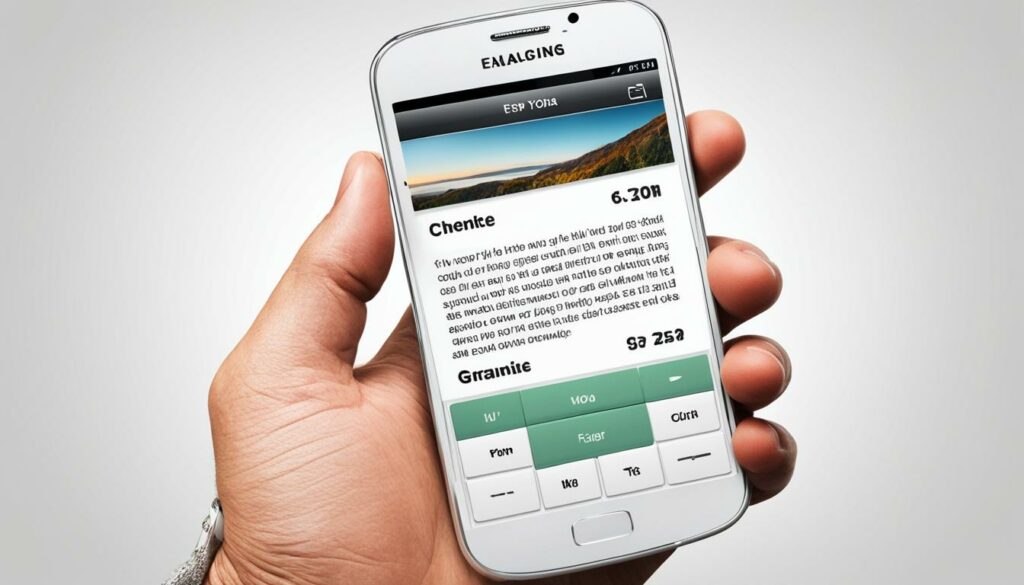Welcome to the world of mobile-friendly design! In today’s digital landscape, it’s more important than ever to ensure that your website elements are optimized for mobile devices. With approximately 60% of internet traffic coming from mobile devices, you can’t afford to ignore the needs of your mobile users.
Having a mobile-friendly website goes beyond just being responsive to different screen sizes. It’s about creating a seamless user experience that allows visitors to easily navigate through your site, access information, and take action. One crucial aspect of mobile-friendly design is making your elements clickable, so users can interact with your site effortlessly.
Key Takeaways:
- Creating a mobile-friendly website is essential to cater to the increasing number of mobile users.
- A mobile-friendly website improves search engine rankings and provides a better user experience.
- Make your website elements clickable to enhance user interaction and ease of navigation.
- Optimize your website for mobile devices by following best practices such as using a responsive layout, optimizing website speed, and avoiding pop-ups.
- Typography and readability play a crucial role in mobile-friendly design, so choose fonts and sizes that are legible on smaller screens.
Importance of Mobile-Friendly Websites
A mobile-friendly website is essential for improving your search engine ranking and attracting more internet traffic. With approximately 60% of internet traffic coming from mobile devices, it is crucial to cater to mobile users and provide them with an optimal browsing experience.
Mobile-friendly websites adjust their layout and features to fit different screen sizes, ensuring that your content is easily accessible and readable on smartphones and tablets. This adaptability not only improves user experience but also boosts your search engine rankings, as search engines prioritize mobile-friendly websites in their results.
Having a mobile-friendly website is no longer a choice; it is a necessity in today’s digital landscape. If your website is not optimized for mobile devices, you risk losing out on a significant portion of your potential audience.
A mobile-friendly website should also load quickly and offer mobile-specific features such as click-to-call and optimized navigation menus. These features enhance usability and make it easier for mobile users to engage with your website.
Benefits of a Mobile-Friendly Website
Creating a mobile-friendly website has several benefits:
- Improved search engine visibility and ranking
- Increased internet traffic and user engagement
- Enhanced user experience and satisfaction
- Higher conversion rates and sales
A mobile-friendly website not only helps you reach a wider audience but also gives you a competitive edge in the online marketplace. By investing in mobile optimization, you can attract more visitors, keep them engaged, and ultimately drive more business.
| Mobile-Friendly Website | Non-Mobile-Friendly Website |
|---|---|
| Higher search engine ranking | Poor search engine visibility |
| Improved user experience | Difficult navigation on mobile devices |
| Increased internet traffic | Lower visitor retention |
| Higher conversion rates | Lower sales and leads |
As the table above illustrates, having a mobile-friendly website can significantly impact your online presence and business success.
Best Practices for Mobile-Friendly Design
Creating a mobile-friendly website involves following certain best practices to ensure optimal user experience. By implementing these strategies, you can enhance your website’s accessibility and usability on various mobile devices.
Responsive Layout
A key practice in mobile-friendly design is developing a responsive layout. A responsive layout adjusts the website’s design and content to fit different screen sizes and orientations. This ensures that users can easily navigate and view your website regardless of the device they are using. It provides a seamless and consistent experience for all visitors.
Website Speed
Website speed is crucial for mobile-friendly design. Slow-loading websites can lead to high bounce rates and frustrate users. To optimize website speed, consider the following:
- Minimize file sizes by compressing images without compromising quality. This reduces load time without sacrificing visual appeal.
- Optimize code and scripts to minimize unnecessary requests and reduce server response time.
- Use caching techniques to store and retrieve static assets, speeding up subsequent visits to your website.
HTML5 and Avoid Pop-ups
Mobile-friendly design relies on modern web technologies. Utilizing HTML5 instead of Adobe Flash allows for better compatibility and performance on mobile devices. Additionally, avoiding pop-ups is important as they can hinder user experience and disrupt the flow of navigation. Instead, consider using alternative methods such as banners or small overlay elements for important messages or calls to action.
Optimized Button Size and Placement
Ensuring that buttons and clickable elements on your website are optimized for mobile devices is crucial. Here are some best practices:
- Make buttons large enough to be easily tapped with a finger, avoiding accidental taps on nearby elements.
- Provide enough spacing between buttons to minimize the risk of users tapping the wrong element.
- Consider the placement of buttons for easy and comfortable reach, especially on larger devices like tablets.
By following these best practices, you can create a mobile-friendly website that provides an optimal user experience for your visitors, leading to increased engagement and better conversion rates.

Typography and Readability
When it comes to creating a mobile-friendly website, typography plays a crucial role in ensuring readability. The right choice of font size and type can greatly enhance the legibility of your content on smaller screens. To optimize readability on mobile devices, sans serif fonts are widely recommended. These fonts have clean lines and minimal flourishes, which make them easier to read in smaller sizes.
Adequate spacing between lines, also known as leading, is another important consideration for improving readability on mobile devices. Providing enough space between lines helps prevent text from appearing cramped and ensures a comfortable reading experience for your website visitors.
Additionally, it’s essential to choose font colors that contrast well with the background. High contrast between the text and the background enhances legibility and readability, especially on mobile screens where visibility may be limited.
“Typography is not only about choosing beautiful fonts, but also about creating an effortless reading experience for your users. Prioritizing readability in your mobile design will keep your visitors engaged and coming back for more.”
Font Size and Legibility
The font size you choose has a significant impact on how easily your content can be read. On mobile devices, where screen real estate is limited, it’s important to strike a balance between making the text large enough to be readable and fitting enough content on the screen.
As a general guideline, aim for a font size of at least 16 pixels for body text and 22 pixels for headings. Larger font sizes make it easier for users to read your content, especially on smaller screens.
Remember that different fonts have varying x-heights, the height of lowercase letters. Fonts with larger x-heights tend to appear bigger at the same font size, making them a good option for mobile readability.
Optimizing Line Length
Line length, or the number of characters per line, also impacts readability on mobile devices. Lines that are too long can be difficult to track, leading to eye strain and reduced comprehension. Conversely, lines that are too short can break the flow of reading.
For optimal readability, aim for a line length of around 50-75 characters per line. This length strikes a balance between providing enough content per line and ensuring comfortable reading for your website visitors.
The Power of White Space
Whitespace, or the empty space between elements, is a powerful tool for improving readability on mobile devices. Providing sufficient whitespace around text blocks and other elements helps create visual separation and improves overall clarity.
Consider incorporating ample whitespace between paragraphs, headings, and other content blocks to enhance readability. This not only improves the visual appeal of your website but also makes it easier for users to scan and navigate your content.
| Typography Tips for Mobile-Friendly Websites |
|---|
| Choose sans serif fonts for improved legibility. |
| Optimize font size for readability on smaller screens. |
| Ensure sufficient spacing between lines for an effortless reading experience. |
| Select font colors that contrast well with the background. |
| Pay attention to line length and aim for around 50-75 characters per line. |
| Utilize whitespace effectively to enhance readability and visual appeal. |
User Experience and Usability
Creating a mobile-friendly website involves more than just responsive design. It’s about delivering a positive user experience and ensuring usability. When visitors access your site on their mobile devices, they expect seamless navigation and functionality. Any hurdles they encounter, such as website crashes or formatting issues, can lead to frustration and high bounce rates. To provide the best mobile web experience for your users, it’s crucial to prioritize usability and address any potential issues.
“A mobile website that is difficult to use can quickly turn away potential customers. A seamless user experience improves engagement and encourages visitors to explore more of your content.”
Mobile-Friendly Usability Tips
- Test your mobile website extensively to identify and fix any formatting issues or bugs that may hinder usability.
- Ensure that all clickable elements on your mobile site are easily tappable, with enough space between them to prevent accidental clicks.
- Optimize your website’s load time by compressing images and minimizing bloated code.
- Use a user-friendly and intuitive navigation menu that makes it easy for visitors to find what they’re looking for.
- Limit the use of pop-ups on your mobile site, as they can disrupt the user experience.
- Evernote, a popular note-taking app, provides an excellent example of mobile usability. With a clean and intuitive interface, users can effortlessly create and organize notes on their mobile devices.
In addition to addressing usability issues, focusing on user experience enhances the effectiveness of your mobile site. Prioritizing both usability and user experience will not only improve your mobile website’s performance but also foster a positive impression of your brand.

Website Speed and Optimization
When it comes to mobile-friendly design, site speed plays a crucial role in delivering a positive user experience. Slow-loading websites not only frustrate users but also negatively impact their overall experience. To ensure that your website offers optimal performance on mobile devices, it’s essential to prioritize website speed and implement efficient optimization strategies.
One valuable tool that can help improve your site speed is Google PageSpeed Insights. By utilizing this tool, you can gain valuable insights into your website’s performance and identify areas for improvement. Google PageSpeed Insights analyzes various factors that affect website load time, such as file sizes, server response, and caching. It then provides recommendations for optimizing these elements and enhancing your site’s speed and overall performance.
Apart from using Google PageSpeed Insights, there are several other optimization techniques you can incorporate to boost your website’s loading speed:
- Compress images: Reduce file sizes without compromising image quality, reducing the time it takes for images to load on mobile devices.
- Minimize HTTP requests: Reduce the number of requests made to the server by combining multiple files, such as CSS and JavaScript, into a single file.
- Enable browser caching: Leverage caching mechanisms to store frequently accessed files locally on users’ devices, allowing for faster subsequent visits.
- Optimize CSS and JavaScript: Minify and compress CSS and JavaScript files to reduce their size, thus improving load times.
- Utilize lazy loading: Prioritize the loading of visible content, and defer the loading of non-visible elements until they are needed, reducing initial load time.
Monitor Key Metrics
Monitoring key metrics related to mobile device load time is essential to ensure optimal performance. Two critical metrics that should be monitored are First Contentful Paint and Time to Interactive. First Contentful Paint measures the time it takes for the first piece of content to appear on the screen, providing users with visual feedback and indicating that the website is loading. Time to Interactive, on the other hand, measures the time it takes for a webpage to become fully interactive, enabling users to engage with the site’s features and functionality.
By regularly monitoring these metrics and making improvements based on the insights gained from tools like Google PageSpeed Insights, you can optimize your website and ensure that it loads quickly, providing a seamless and enjoyable mobile browsing experience for your users.
Implementing optimization measures to enhance your website’s speed will not only improve your user experience but also contribute to better search engine rankings. Combining mobile-friendliness with quick load times ensures that your website is accessible and enjoyable for users on various devices, ultimately boosting engagement and conversions.
Mobile Design and Brand Continuity
When it comes to creating a mobile-friendly website, it’s essential to ensure brand continuity across different screens. Maintaining consistency in elements like logos, colors, and fonts helps reinforce brand identity and recognition. By ensuring that your mobile design aligns with your overall brand aesthetic, you can create a cohesive and memorable user experience.
A mobile-friendly design should include responsive design practices, allowing your website to adapt seamlessly to different devices. Responsive design ensures that your website layout and features are optimized for mobile devices, providing an optimal user experience regardless of the screen size.
Website customization is another crucial aspect of mobile design. Offering customization options allows you to tailor your mobile design to meet your brand’s specific requirements and preferences. Whether it’s adjusting the layout, adding unique features, or personalizing the user interface, website customization ensures that your mobile design reflects your brand’s unique personality.
By prioritizing brand continuity, responsive design, and website customization, you can create a mobile-friendly design that not only enhances the user experience but also reinforces your brand’s identity and strengthens your online presence.
| Mobile Design and Brand Continuity | Benefits |
|---|---|
| Consistent brand elements (logos, colors, fonts) | Enhances brand recognition and identity |
| Responsive design | Optimal user experience on all devices |
| Website customization | Tailored design to meet brand requirements |
Creating a mobile design that aligns with brand continuity, incorporates responsive design, and offers customization options ensures that your website leaves a lasting impression on mobile users, strengthening your brand’s online presence and driving user engagement.
Benefits of Mobile-Friendly Design
Mobile-friendly design offers numerous benefits for website owners. One of the key advantages is improved search engine optimization (SEO). By creating a mobile-friendly website, you provide a better user experience, which search engines like Google prioritize. As a result, your website is more likely to rank higher on search engine results pages, increasing its visibility and attracting more organic traffic.
In addition to SEO benefits, a well-designed mobile site also enhances user engagement. When your website is optimized for mobile, visitors are more likely to spend more time on your site and explore multiple pages. This increased user engagement can lead to higher conversion rates and better overall performance for your website.
Positive user experiences on mobile devices also play a significant role in improving website performance. When users have a seamless and enjoyable experience on your mobile site, they are more likely to recommend and share it with others. Word-of-mouth referrals and social sharing can drive additional traffic to your website, amplifying its reach and impact.
In summary, investing in mobile-friendly design offers tangible benefits like improved search engine rankings, increased user engagement, and enhanced website performance. By prioritizing mobile optimization, you can effectively reach and engage with your target audience, leading to better overall results for your online presence.
FAQ
How important is it to make your website elements mobile-friendly and clickable?
Making your website elements mobile-friendly and clickable is crucial for providing a better user experience on mobile devices. With approximately 60% of internet traffic coming from mobile devices, it is essential to cater to this audience by ensuring that your website adjusts to different screen sizes and provides features that are touch-friendly and easily clickable.
Why is having a mobile-friendly website important for search engine rankings?
Having a mobile-friendly website is important for search engine rankings because search engines prioritize mobile-friendly sites. By optimizing your website for mobile devices, you can improve your search engine optimization (SEO) efforts and increase your chances of ranking higher in search engine results pages, ultimately driving more organic traffic to your site.
What are some best practices for creating a mobile-friendly website?
Some best practices for creating a mobile-friendly website include developing a responsive layout that adapts to different screen sizes, optimizing website speed to ensure fast loading times, compressing images to reduce page size, using HTML5 instead of Adobe Flash, and avoiding pop-ups that may disrupt the mobile user experience. Additionally, it is crucial to optimize button size and placement to make them easily clickable on mobile devices.
How does typography affect the readability of a mobile-friendly website?
Typography plays a significant role in the readability of a mobile-friendly website. Choosing the right font size and type is essential for ensuring legibility on smaller screens. Sans serif fonts, such as Arial or Helvetica, are commonly recommended for mobile websites as they are easier to read in smaller sizes. Adequate spacing between lines and proper leading also contribute to improved readability on mobile devices.
Why is user experience and usability important for mobile-friendly websites?
User experience and usability are crucial for mobile-friendly websites because mobile web users expect websites to be fast-loading and user-friendly. Visitors should be able to navigate and use the website easily without encountering crashes or formatting issues. Failing to provide a positive user experience can lead to high bounce rates and may discourage users from engaging with your website.
How does website speed and optimization impact mobile-friendly design?
Website speed is a critical aspect of mobile-friendly design. Slow-loading websites can deter users and negatively impact user experience. Optimizing website speed, through techniques such as compressing images and minimizing HTTP requests, is crucial to ensure fast loading times and a smooth browsing experience on mobile devices. Tools like Google PageSpeed Insights can help identify areas for improvement and ensure optimal loading speed for mobile users.
How can mobile design maintain brand continuity?
Mobile design should align with the overall brand continuity of a website. Consistency in logos, colors, and fonts across different screens helps maintain brand identity and creates a cohesive experience for users. Responsive design, which adapts to different devices, allows for a seamless user experience and ensures that the brand’s visual elements remain consistent across all devices. It is also important to provide customization options to tailor the mobile design according to the brand’s specific requirements.
What are the benefits of mobile-friendly design?
Mobile-friendly design offers several benefits for website owners. It improves search engine optimization by providing a better user experience, leading to higher rankings on search engine results pages. A well-designed mobile site increases user engagement, as visitors are more likely to spend more time on the site and navigate to more pages. Positive user experiences also lead to higher recommendations and sharing of the website, further enhancing its performance.











